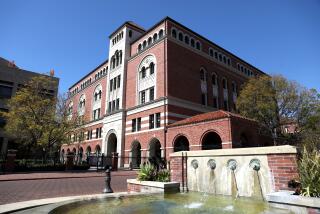UC Berkeley suffers big loss in CRISPR patent fight: What’s next for the powerful gene-editing technology?
The scientists who first harnessed the powerful gene-editing technology known as CRISPR suffered a major defeat Wednesday in their long-running quest to control the rights to their invention.
UC Berkeley biochemist Jennifer Doudna and her European collaborator, Emmanuelle Charpentier, have racked up a slew of awards for their work, which makes it very easy to alter the DNA of living things. But their efforts to patent their discovery have been hung up by a competing claim from Feng Zhang at the Broad Institute of MIT and Harvard.
On Wednesday, the federal Patent Trial and Appeal Board sided with the Broad Institute and against UC Berkeley. The board, part of the U.S. Patent and Trademark Office, ruled that Zhang’s patent claims do not interfere with those put forth by Doudna and Charpentier, and they allowed his patent to stand.
Patent battles are usually dull, but this one has captivated the scientific community.
“It’s not an exaggeration to say it may be one of the greatest life science inventions ever,“ said Robin Feldman, director of the Institute for Innovation Law at the UC Hastings College of the Law in San Francisco. “CRISPR is a gold mine, and that’s why you are seeing a gold rush.”
Read on to learn more about what’s going on, and why.
What is CRISPR anyway?
CRISPR is a powerful and relatively new gene-editing system that has revolutionized scientists’ ability to make precise changes in DNA.
It has been used in labs to correct for the mutation that causes sickle cell disease, create mosquitoes that can fight malaria in their bodies, and make crops more resistant to disease and drought.
You can learn more about CRISPR and how it works here.
Who invented it?
Technically, bacteria. They and other single-celled organisms have been using the combination of a guide RNA and a scissors-like protein, called Cas9, to chop up the DNA of unfriendly viruses for hundreds of million of years.
However, the first paper to demonstrate CRISPR’s ability to edit DNA in the lab was published by Doudna and Charpentier in Science. That was back in the summer of 2012.
Did UC Berkeley file a patent for the invention?
Yes. In March of 2013, UC Berkeley and the University of Vienna, where Charpentier worked at the time, filed for a U.S. patent that included 155 claims to the general CRISPR-Cas9 technology.
If the patent is issued, it means a biotech company that wants to use this CRISPR system would have to get a license either from the Berkeley group or from a company that has already licensed the technology from them.
Where does the Broad Institute come in?
Doudna and her team were the first to show that the CRISPR system could be used to alter genes in prokaryotic cells. But Zhang, a biologist at the Broad Institute, was the first researcher to show that CRISPR could be used to alter genes in eukaryotic cells, which are the types of cells in plants and animals. The Broad Institute filed a patent for his findings in October 2013, a few months after the Berkeley group filed its patent.
Because the Broad’s patent had fewer claims, it was eligible for an accelerated approval process. Its patent was issued on April 15, 2014.
The Berkeley group’s patent has not been issued.
Are the two patents different?
Yes. The Berkeley patent application is much more broad than the Broad patent. On Wednesday, Doudna explained that the University of California’s patent encompasses the use of CRISPR in all cells, while the Broad’s patent only applies to the use of CRISPR in eukaryotic cells.
However, the most lucrative applications of CRISPR are likely to be in eukaryotic cells, since those are the ones involved in human health.
So what exactly was this ruling about?
After the Broad’s patent was issued, the Berkeley group filed what’s known as an interference, arguing that the Broad’s patent should never have been granted. The Berkeley group claimed it was obvious for someone with a reasonable amount of scientific skill to go from the gene-editing applications of CRISPR that Doudna and Charpentier outlined in their 2012 paper to similar applications in eukaryotic cells. If that is indeed the case, the Broad Institute would not be deserving of a distinct patent.
The Broad argued that these applications were not obvious, and therefore the two patents represent different patent claims. As part of their argument, lawyers for the Broad cited Doudna’s statements that her group was having trouble getting CRISPR to work in eukaryotic cells.
The Patent Trial and Appeal Board agreed with the Broad.
So where does the case stand now?
When the Berkeley group filed the interference, it put its own patent process on hold. That will now go forward. If it goes through, as expected, it’s possible that companies that want to use CRISPR in eukaryotic cells will have to get licenses from both the Broad and the Berkeley group.
Overlapping patents are not unheard of in patent law. However, legal experts expect the Berkeley group will appeal the board’s decision to a federal appeals court. It is also likely that there will be further lawsuits over how far each patent can reach.
“The board’s decision suggests that Zhang’s work represented an appreciable step forward from Doudna’s work, but Berkeley could still argue that they pioneered the broader invention, so what happens next is going to depend on Berkeley’s strategy and how it is received either by the patent office or the federal court,” said Jacob Sherkow, a professor at New York Law School.
Tell me why this matters again?
Money.
Whoever wins the rights to the CRISPR patent will have the opportunity to make extraordinary amounts of money from licensing fees. Some observers estimate the rights are worth billions of dollars.
It’s also possible that the ultimate patent holder will have a monopoly on the technology, and try to cash in on that.
“The patent gives you the right to exclude others from making, using or selling your inventions. So if you can exclude everyone else from the market and develop a viable product, you are the only game in town,” Feldman said. “That is a very valuable right to hold, particularly for a revolutionary technology like CRISPR.”
It should be noted, however, that neither party seems particularly territorial in this case.
“Both the Broad and Berkeley have been generous about letting people use CRISPR for pure academic research,” said Jorge Contreras, a professor of law and human genetics at the University of Utah. “But researchers who want to use it commercially will need a license and will have to pay.”
Could the Broad and Berkeley settle?
In theory, they could reach a settlement and divide up the spoils of their inventions. But experts say that’s not likely to happen in this case. There’s too much bad blood between the parties and too much money at stake.
“When you have economic implications of this magnitude and this level of animosity, it pushes people to fight to the death,” Feldman said.
Do you love science? I do! Follow me @DeborahNetburn and “like” Los Angeles Times Science & Health on Facebook.
MORE IN SCIENCE
‘Extraordinary levels’ of pollution have contaminated even the deepest parts of the Pacific Ocean
To prevent serious medical conditions, scientists should be able to edit people’s DNA, panel says
El Niño triggered unprecedented erosion across California’s coast







